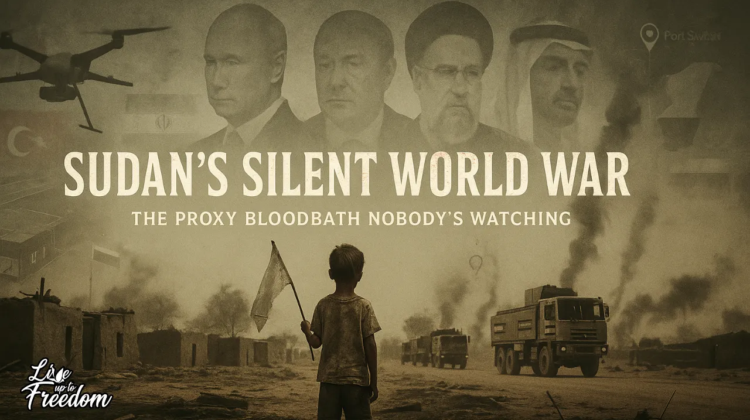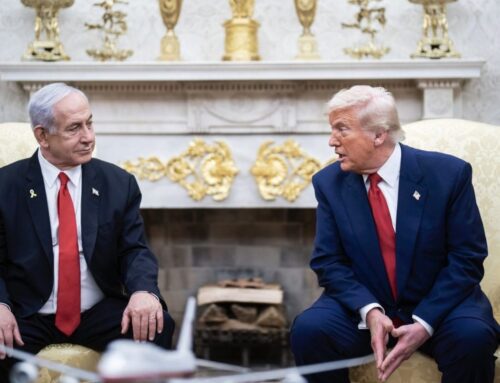NOTE: There is additional “What to do?” information below the article. Please don’t bypass it.
Sudan’s Silent World War
The proxy bloodbath nobody’s watching.
November 17, 2025
By
Reprinted from Frontpage Magazine
In an earlier report, ‘The Major Overlooked Crisis of Our Time’, I laid bare what’s happening on the ground in Sudan.
That report exposed what is happening.
Twelve million people have been displaced. Over 150,000 are dead. And that’s not from bombs alone. It’s from rape militias, tribal cleansings, beheadings, drone strikes, and the kind of medieval brutality that leaves cities in ashes and bodies in mass graves.
But now it’s time to pull back the curtain. Because Sudan is not just a humanitarian crisis, it’s a proxy war, bought and paid for by Islamic regimes, rogue states, and U.S.-backed “allies” who are all fighting for a piece of the Horn of Africa.
And the players? Iran. Turkey. UAE. Egypt. Russia. Pakistan.
The entire region has turned Sudan into a military marketplace. And no one in Washington seems interested in telling the truth.
Instead, we’re all being fed the same two lies:
- That this is an “internal conflict.”
- That no one can stop it.
Sudan didn’t fall into chaos by accident.
Back in 2019, a popular uprising overthrew the longtime Islamist dictator Omar al-Bashir, a man backed for years by Islamists, Muslim Brotherhood networks, and Iranian Quds Force allies. The people wanted democracy. Instead, they got a military junta, followed by two warlords tearing the country in half.
On one side:
General Abdel Fattah al-Burhan, commander of the Sudanese Armed Forces (SAF), is supported by Egypt, Iran, Turkey, Russia, and Pakistan.
On the other:
Mohamed “Hemedti” Dagalo, leader of the Rapid Support Forces (RSF), a former Janjaweed militia chief now backed by the United Arab Emirates, Kenya, and a long line of foreign mercenaries.
But neither side fights alone.
Who Backs the SAF (Sudan Armed Forces)?
Egypt has long been one of the SAF’s closest backers. After the war broke out in April 2023, General Abdel Fattah al-Burhan’s first official visit was to Cairo, where Egyptian President Abdel Fattah el-Sisi reportedly pledged logistical and military support. In November 2025, the RSF accused Egypt of launching drone strikes in Darfur, pointing to flight paths and strike patterns that originated from bases near the Egyptian border. While Egypt denies direct involvement, even Western intelligence sources quoted in Reuters and Middle East Eye confirm a quiet but ongoing weapons pipeline from Cairo to Khartoum.
Turkey claims neutrality. But behind the scenes, it’s supplying lethal firepower to the Sudanese army. In March 2025, Turkish state-linked media openly reported that Ankara delivered advanced Bayraktar TB2 drones to the SAF drones that were then used in an operation to retake parts of Khartoum. The same month, the Washington Post published a defense report confirming that Baykar, Turkey’s top weapons manufacturer, had sold not just drones but hundreds of combat-ready warheads to Sudan. Multiple defense analysts and open-source intelligence platforms have tracked the flight logs and delivery manifests linking Turkish arms to the SAF.
Then there’s Iran, which officially reestablished diplomatic relations with Sudan in October 2023 after a seven-year break. Within months, RSF leader Hemedti publicly accused Tehran of supplying the army with Iranian-made drones. The accusation came just after an SAF aerial offensive in Darfur that included UAV strikes with flight patterns matching Shahid-series drones, previously deployed by Iran in Yemen and Syria. Iran has not responded directly to these claims, but multiple UN arms monitoring bodies have flagged the sudden presence of advanced UAVs in SAF’s arsenal as highly suspicious. The overlap with Iranian drone technology is, in some cases, unmistakable.
Russia has had its eyes on Sudan’s coastline since 2017, when it first proposed building a naval base on the Red Sea. That dream became reality in February 2025, when Moscow signed a formal agreement with Sudan’s military leadership to establish a naval logistics hub in Port Sudan. The base is now part of Russia’s global strategy to project power into the Red Sea and counter Western presence near the Suez. In exchange, Moscow has reportedly supplied spare fighter parts and training modules to SAF officers, according to Bloomberg and Defense News.
On the ground, Eritrea has gone from quiet neighbor to open participant. In January 2025, a SAF-aligned paramilitary faction revealed it was receiving combat training and weapons shipments inside Eritrean territory. The fighters, aligned with the SAF, praised Eritrea’s government for facilitating their movement and arming their ranks. Satellite images from early 2025 appear to confirm at least two known staging camps near the border with Sudan.
And just to make sure every continent is represented, Pakistan stepped in last. In October 2025, Khartoum and Islamabad signed a $230 million defense agreement. The deal includes pilot training, drone technology transfers, joint production of armored vehicles, and support for repairing Sudan’s aging fleet of Russian-made aircraft. The agreement was confirmed by both Pakistani defense ministry sources and Sudanese state television, and it cements Pakistan’s quiet pivot toward deeper military exports under the radar of global scrutiny.
Who Backs the RSF (Rapid Support Forces)
At the top of the RSF’s support chain stands the United Arab Emirates. According to multiple UN Panel of Experts reports and confirmations from Middle East Eye, the UAE has funneled armored vehicles, combat drones, and ammunition to Hemedti’s RSF through a series of proxy routes, primarily via Chad, Libya, Sudan’s southern borders, and Somalia’s Bosaso port. These arms are not humanitarian in nature. They’re heavy weapons, war-ready, and often wrapped in diplomatic immunity. The Emirates continues to deny direct involvement, but the logistics evidence is overwhelming. As early as 2023, photos surfaced of Mine-Resistant Ambush Protected vehicles (MRAPs) traced back to UAE stockpiles appearing in RSF convoys across Darfur.
In February 2025, Kenya dropped its mask of neutrality by hosting RSF political leaders for what they called a “transitional authority summit.” The meeting, held in Nairobi and attended by foreign diplomats and Gulf-linked NGOs, was the RSF’s attempt to legitimize its rule by forming a shadow government in exile. Sudan’s military regime responded swiftly, withdrawing its ambassador from Kenya and publicly accusing Nairobi of enabling terrorism. Kenyan officials tried to downplay the summit as “inclusive diplomacy,” but their role in elevating RSF leadership on the international stage was impossible to hide.
South Sudan, the northern neighbor to RSF-held territories, has been accused by SAF spokesmen of sending mercenaries and medical aid to RSF combat units. Reports from local Sudanese outlets and regional analysts point to wounded RSF fighters being evacuated into South Sudan for treatment. Though the government in Juba denies direct involvement, the pattern is too consistent to ignore, and the cross-border flow of fighters has raised alarm in Ugandan and Ethiopian intelligence circles.
The RSF’s drone warfare capabilities reveal another layer of this proxy puzzle: Chinese combat drones, particularly the Wing Loong series, have been spotted in RSF hands since 2024. Experts believe the UAE first purchased these drones as part of its standard arms contracts with China, then diverted to Sudan via third-party operators. While Beijing maintains plausible deniability, open-source intelligence has traced serial numbers and components that link RSF drone strikes to UAE-held Chinese inventory.
Even more telling is the RSF’s reliance on foreign mercenaries. Multiple battlefield testimonies and intercepted radio chatter, some analyzed by Western intelligence firms and published in reports from The Africa Report, suggest that the RSF is deploying drone pilots, technical specialists, and battlefield consultants from Ukraine, Colombia, and across Africa. Some are believed to be former Wagner operatives seeking Gulf-financed contracts. Others are regional warfighters hired through military contractor intermediaries operating out of Dubai and Nairobi.
What Hemedti has built is not a national army. It’s a transnational militia, bankrolled by petrodollars, trained by ghosts, and supplied by regimes that find war more profitable than peace.
The U.S., along with Saudi Arabia, Egypt, and the UAE, has tried to push a ceasefire deal. But Sudan’s military refuses to even sit at the table if the UAE is present, accusing Abu Dhabi of direct support for the RSF.
In November 2025, the RSF agreed to a three-month ceasefire. SAF did not. Instead, they asked for Turkey and Qatar to join future talks, further proof that this is no longer just a local conflict.
This is a war with global fingerprints, where ideology, arms sales, territorial ambition, and deception collide.
Sudan borders seven countries, sits on untapped gold and oil, and controls access to the Red Sea. Whoever wins this war will strategically, economically, and ideologically influence a critical region.
And make no mistake: Iran is betting on the army, while the UAE is building a militia-run state.
Meanwhile, millions starve, children die, and Western media barely blinks.
If you still believe these regimes stand united, this war proves otherwise.
Because in Sudan, all the masks fall off.
China is supplying drones used by UAE-backed RSF militias against an army backed by Iran.
So much for the myth that Beijing and Tehran are building a united front.
Russia signs a naval base deal with the Sudanese military while Wagner-style mercenaries work with the UAE-funded militia, killing the military’s soldiers.
So much for the myth of Moscow as a loyal partner to its Axis of Resistance allies.
Turkey and Egypt are framed as U.S. allies, moderate, stable, and supposedly opposed to Iran’s ambitions. Iran is painted as the rogue.
Yet in Sudan, all three are arming the same army, fighting the same war, for the same strategic foothold.
So much for America’s genius understanding of “the enemy of my enemy.”
And the United Arab Emirates?
That shining “modern” state, the one that hosts climate summits, builds skyscrapers, and smiles for global photo ops, has been arming militias who commit ethnic cleansing, torch entire villages, and turn refugee camps into mass graves.
So much for the myth of reform, alliance, and morality.
This war proves one thing: these regimes care about influence.
They care about Red Sea access, gold mines, weapons contracts, and power projections.
Sudan is their war room. It’s people, their bargaining chips.
And the West? Still shaking hands.
Still signing defense deals.
Still pretending that “peace talks” with these butchers are progress.
But now, at least, the mask is off.
~~~~~~~~~~~~~~~~~~~~~~~
What can you do?
A couple of very real things. Pray faithfully and earnestly for the word of salvation, Jesus Christ, to be heard, preached, read, absorbed, believed in Sudan, as well as being able to LITERALLY FREE HUMAN SLAVES IN SUDAN!
Watch the video below. Visit Christian Solidarity International. Do whatever you can. Tell your relatives, your neighbors, your co-workers, your professed brothers and sisters in the faith, TELL YOUR PASTOR, and then DO SOMETHING about it.
Christian Solidarity International: https://csi-usa.org/metaxas/
Eric Metaxas begins the episode with Todd Chatman from Christian Solidarity International, who shares the stunning reality that slavery is still happening today in Sudan and explains how CSI has already freed more than 120,000 people. Todd describes how every $250 gift directly rescues an enslaved person and provides the essentials needed to start a new life. In the second half, John Zmirak joins Eric for a sobering look at America’s cultural decline and asks whether we are drifting toward a soft totalitarian state. Zmirak explains how ideology, propaganda, and weaponized compassion are reshaping society and why Christians must recover discernment before freedoms vanish. The episode connects global injustice with domestic cultural decay in one urgent conversation.
Link to the video if unable to open it by clicking on the image.








Leave A Comment
You must be logged in to post a comment.